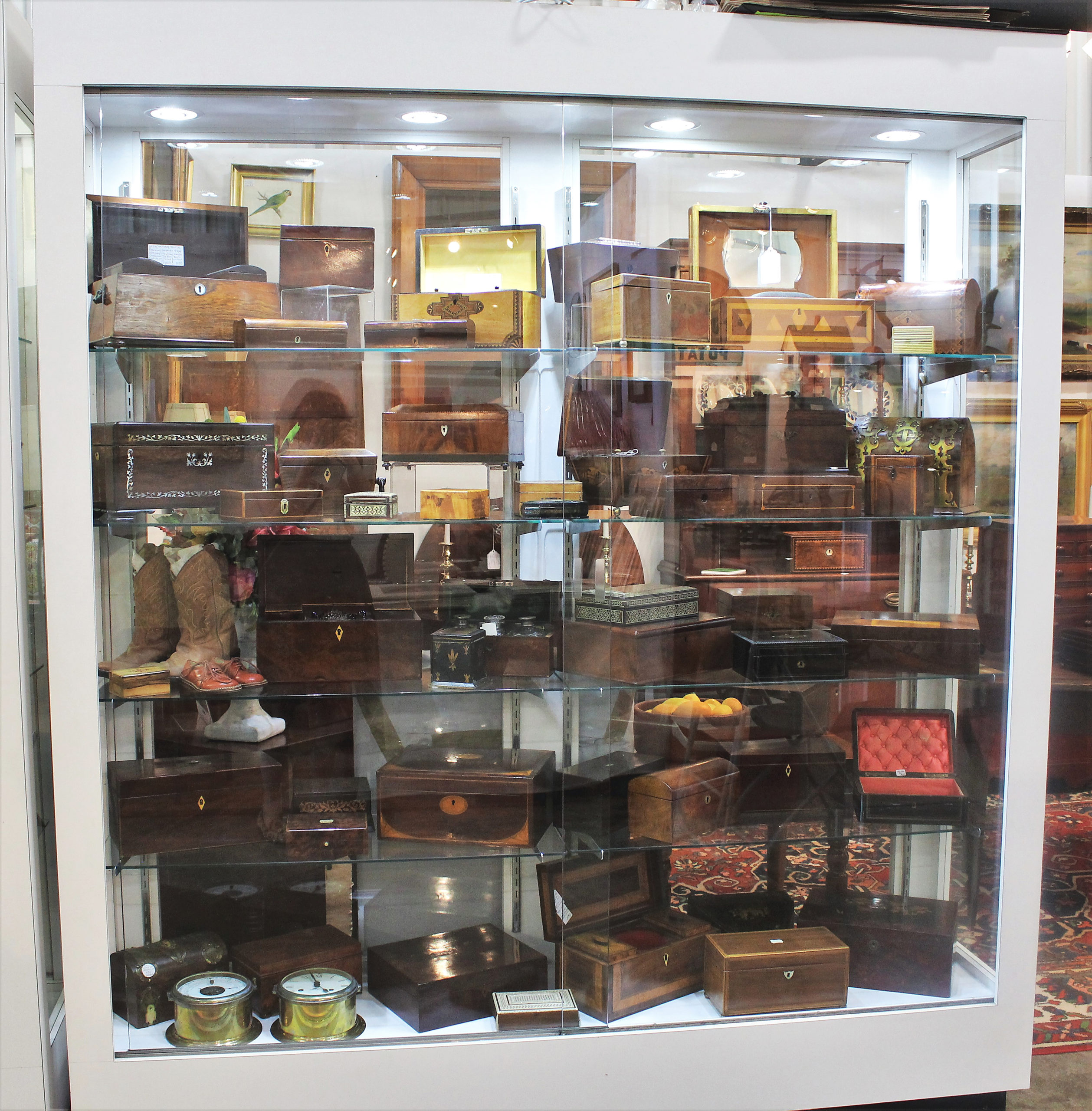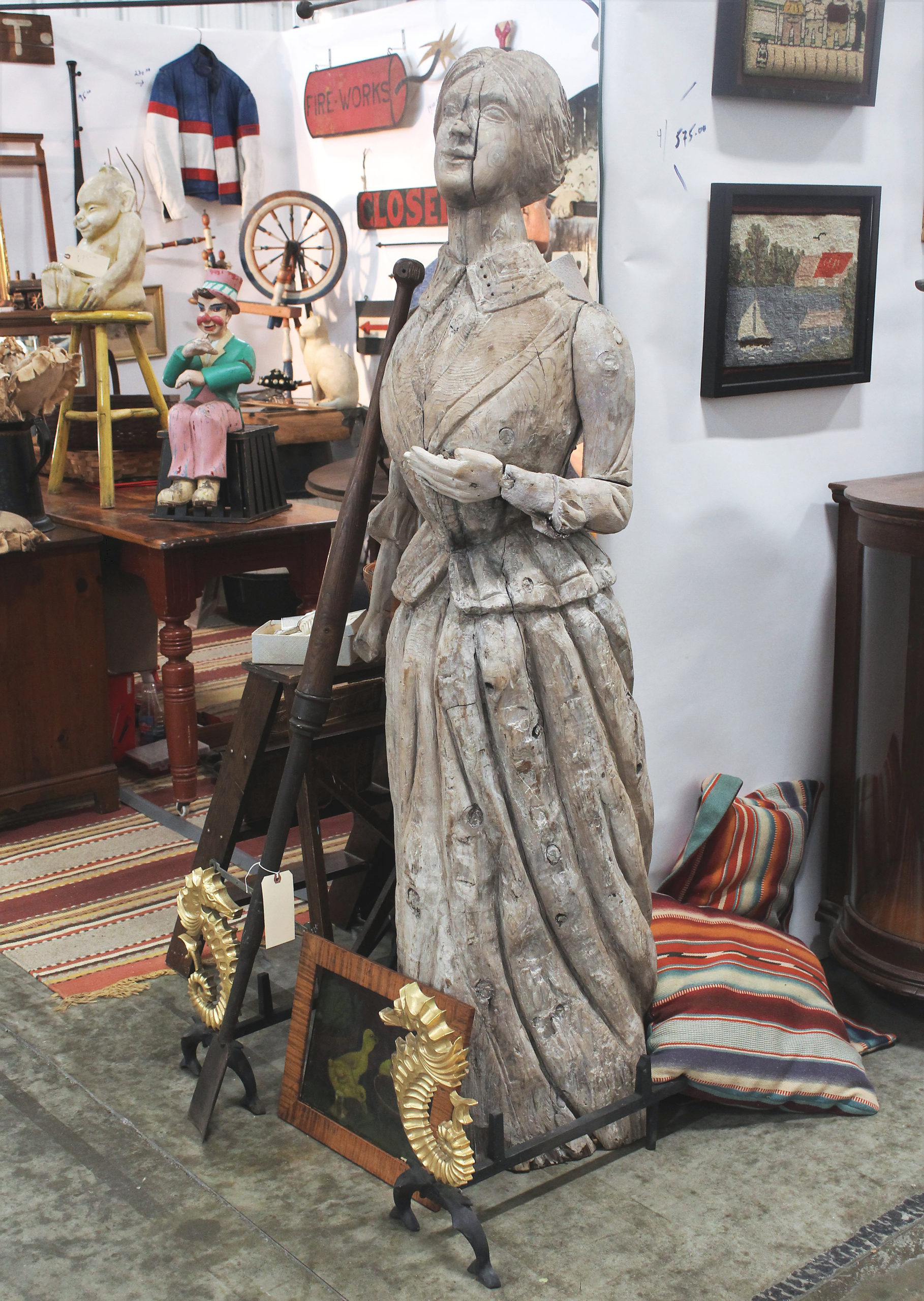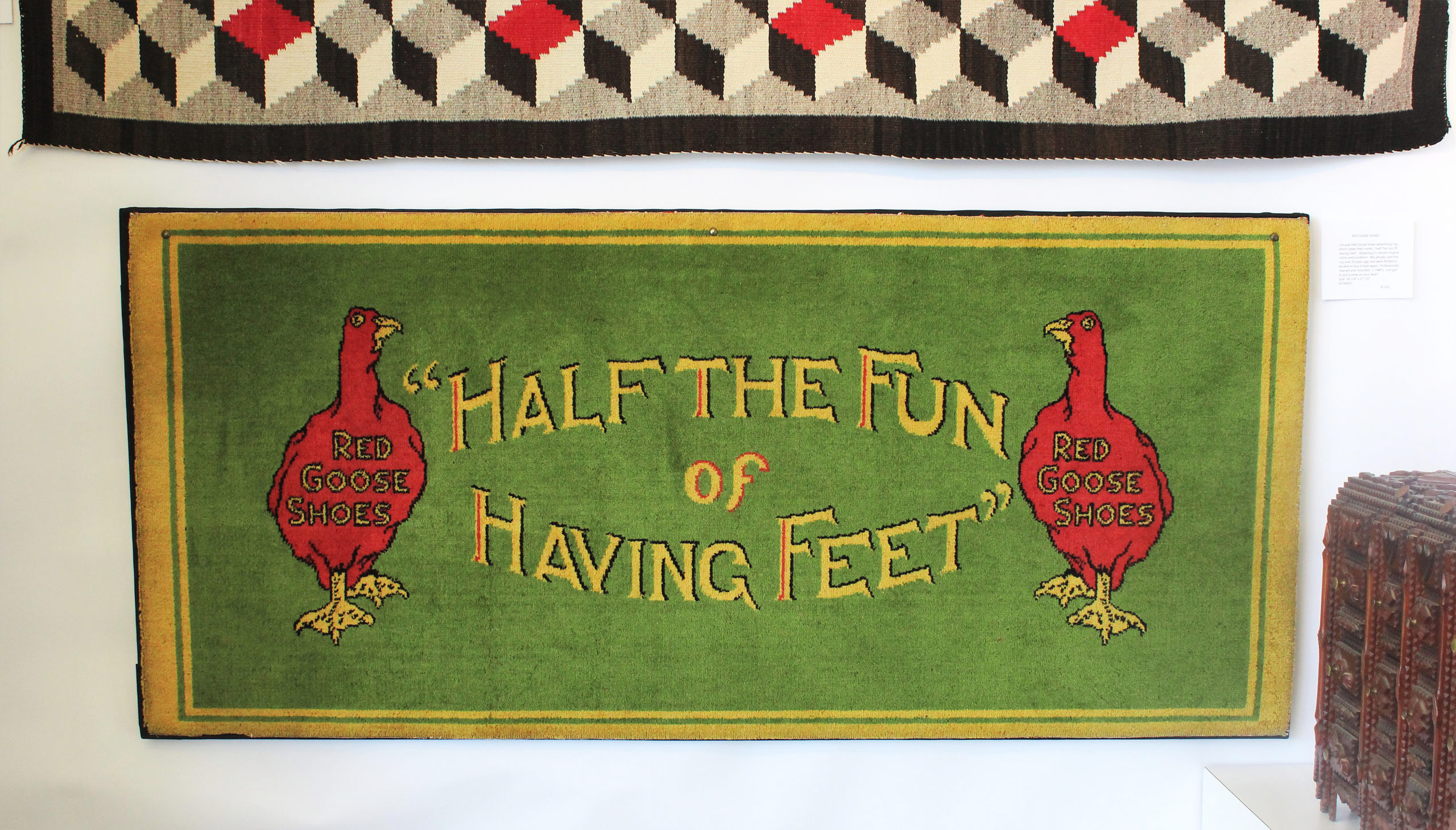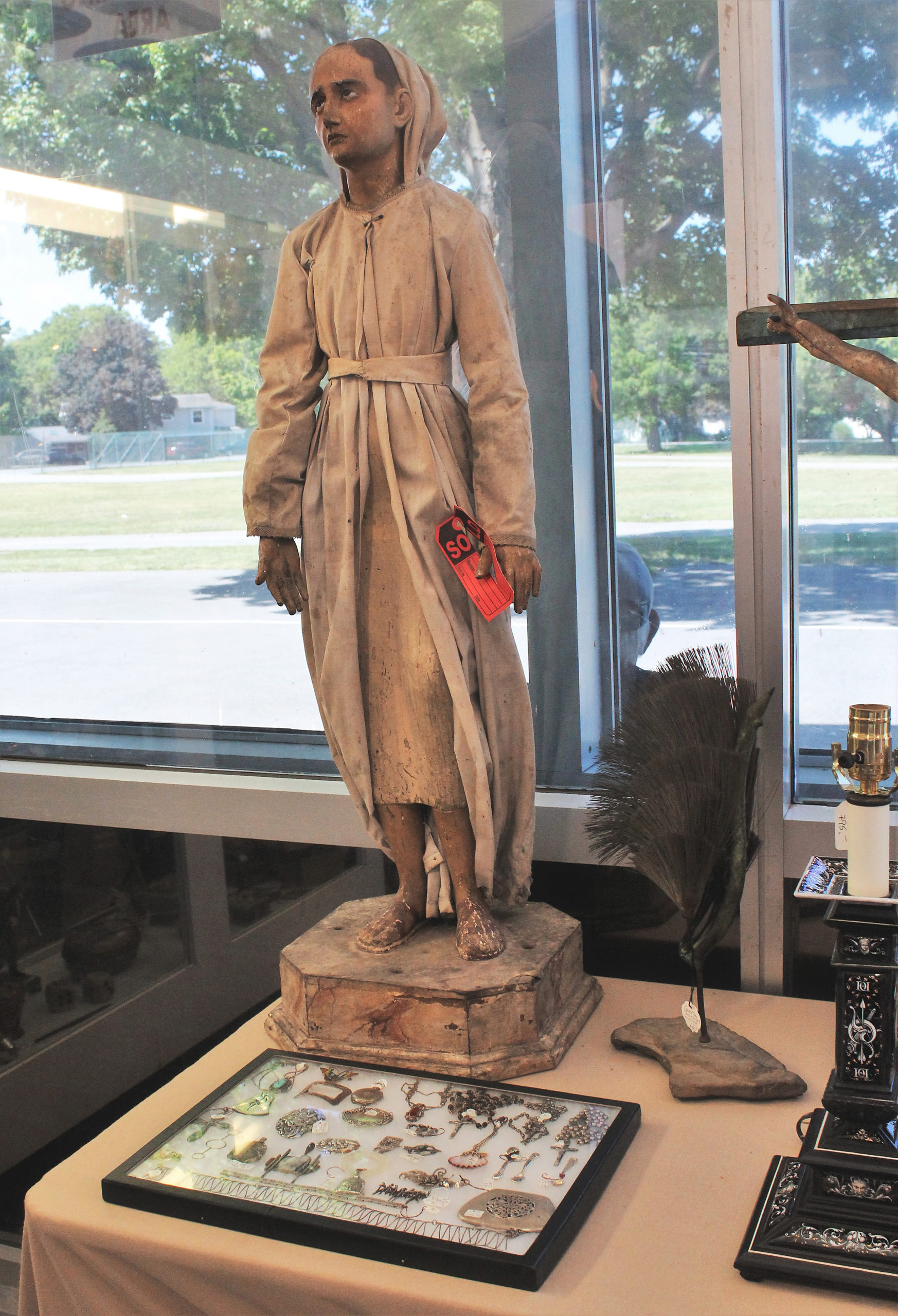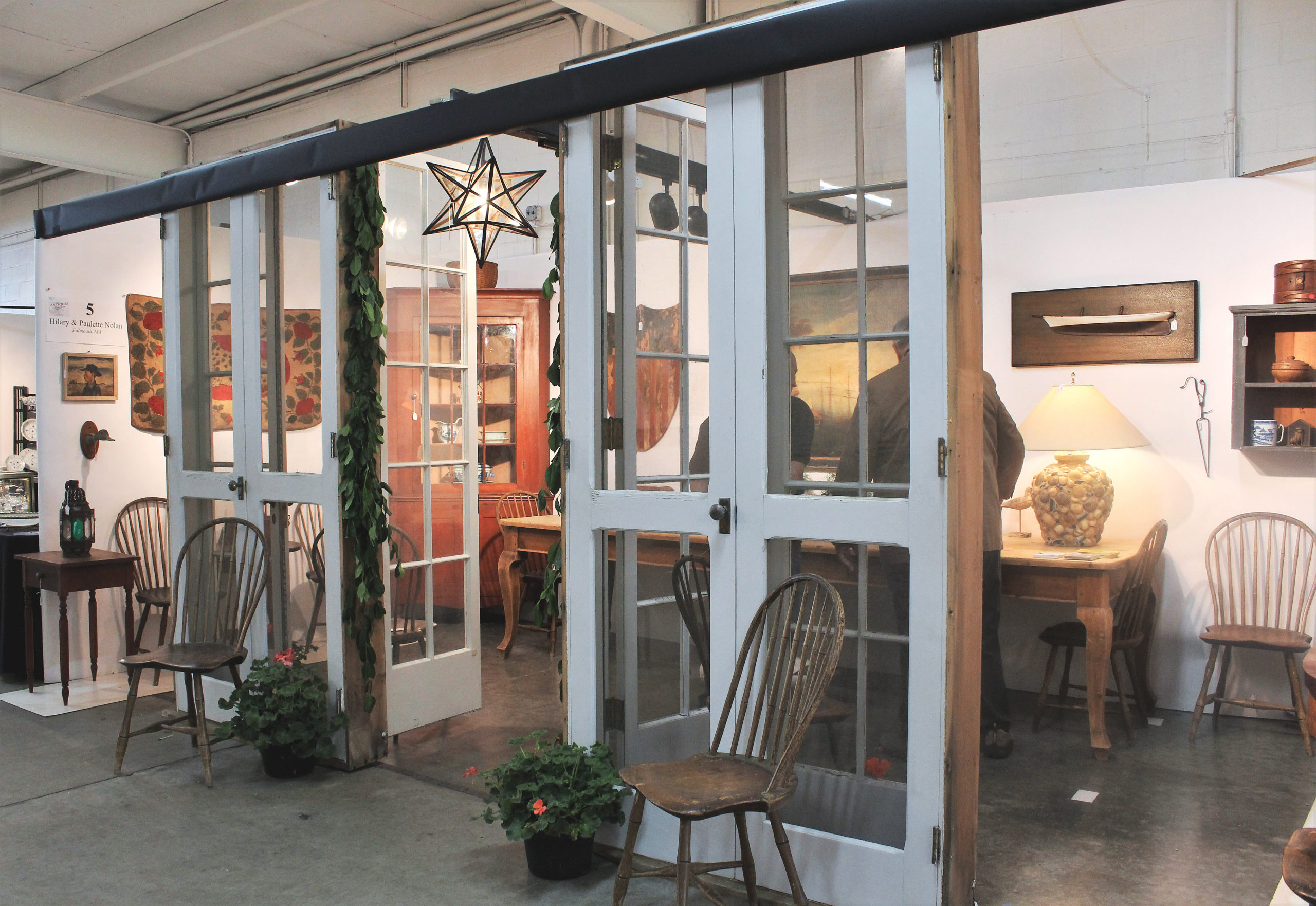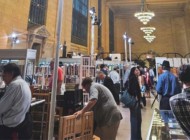
Frank Gaglio of Barnstar Productions announced the opening of the gates over the intercom, releasing the first wave of early bird shoppers at Rhinebeck.
Review & Onsite Photos by Z.G. Burnett
RHINEBECK, N.Y. — The weather welcomed Barn Star Productions’ Spring Antiques at Rhinebeck show on May 27-28, stunning both dealers and customers with sunshine in the semi-open air of the Dutchess County Fairgrounds pavilion. Early birds flooded the show’s three buildings, housing 125 dealers, and their numbers only grew throughout the day. Frank Gaglio of Barn Star Productions reported that crowds came early and stayed late on Saturday. Many returned on Sunday, and “[left] with items they thought about overnight that they just couldn’t live without.” A number of young families were in attendance, as well as veteran showgoers whose surprise at the number of attendees was frequently overheard. Gaglio reported that the gate was up around 20 percent from the last show, which he attested to the show’s social media campaign headed by his daughter, Ciara. Antiques at Rhinebeck’s online presence has notably increased, using platforms like Instagram to exhibit highlights from this and past events.
The careful and appealing arrangements that come together so beautifully at the Dutchess County Fairgrounds truly make this event into a “show.” There is always a wide variety of goods available at Rhinebeck, with traditional categories such as fine art, folk art, American and European furniture, period textiles and architectural elements represented in abundance. These were complimented by those who specialized in Midcentury Modern décor, Outsider art and contemporary design. Many dealers were returning to Rhinebeck after being on hiatus, and others were setting up there for the first time. Industry figures and collectors of all levels could be spotted with shopping bags and armfuls of goods due to appropriate and accessible pricing throughout. Another attractive feature of the show is just how easy it is to purchase and transport goods, assisted by a team of porters who swiftly move larger goods down to customers’ cars by golf cart, allowing them to continue shopping.

Early Twentieth Century bass cello case, Village Braider Inc, Plymouth, Mass.
Coming up from the fairgrounds parking lot, visitors were greeted by an early Twentieth Century wooden cello case that was taller than most who walked past it, showcased in Village Braider Inc’s booth, Plymouth, Mass. The case, and the bass cello that it once housed, belonged to Spanish musician Juan Biscarri, whose name and New York City address was found on an exterior shipping label accompanied by another warning “muy fragil.” “I’m not a musician,” said Bruce Emond after the show. “Just liked the sculptural quality of it.” The Village Braider’s booth was almost empty by the end of the show, and the case was still available at press time.
Another standup wooden sculpture was brought by Robert T. Baranowsky, Fine Antiques, Rockfall, Conn., of a woman carved in the round from one piece of wood, likely from the 1840s. In the style of masthead, the woman was shown fully clothed and would have been used as a trade side for a seaport storefront. Further into Baranowsky’s booth was a slightly more risqué piece of marketing material: a cloth basket formed in the shape of a brassiere. “If I had a nickel for every time someone asked me about that…” he said, adding that it was one of three in stock. There was “keen interest” in both the Nineteenth Century lady and her Midcentury Modern counterpart, but neither belonged to Baranowsky’s many sales of the day, including a large apothecary and trade signs. This was his first time back at Rhinebeck in ten years, and Baranowsky reported that it was a welcome return.
The show was replete with advertising pieces, but one in particular “just got to put a smile on your face!” Robert Snyder and Judy Wilson, Lititz, Penn., brought an unusual Red Goose Shoes branded rug that retained its vibrant colors and was in fantastic condition. The rug showed two emblematic red geese on either side of the company’s slogan, “Half The Fun of Having Feet.” Snyder and Wilson sold this rug 20 years ago, and were “thrilled to be able to buy it back again.” The 1940s rug was professionally cleaned and mounted. The Red Goose Shoe Company, St Louis, Mo., opened operation in 1869 under the name Gieseke-D’Oench-Hayes, after its founders, its primary market being pioneer families heading even further West. Its memorable name came from two sources: “Gieseke” is German slang for “goose,” and during the 1904 St Louis World’s Fair, two stock boys painted the goose on the company’s cartons red, which appealed to the founders who trademarked the name in 1906. Red Goose was absorbed by the International Shoe Company shortly after this rug’s creation.

Chuck Auerbach, Akron, Ohio, brought this rare late Nineteenth Century New York schoolhouse quilt, all facing in the same direction, and was asking $895. The carved figures were offered in a group of four at $7,500 and a group of three at $2,200.
Carpets, quilts and antique textiles were abundant at Rhinebeck. Evan Grant Art and Antiques, Round Pond, Maine, brought an uncommonly large hooked and braided rug hybrid that was its booth’s centerpiece. Grant said that it was likely made in Maine, and was asking $1,400. This was his second time showing at Rhinebeck. Hyde nor Hair, Kingston, N.Y., maintained its title as the sole primarily vintage clothing and accessories dealer of the show, although other booths offered disparate pieces for antique fashion collectors.
Chuck Auerbach Antiques, Akron, Ohio, prominently hung a New York state schoolhouse quilt, dated 1870-80, that was rare for its orientation of the schoolhouses; these quilts are seldom seen with each house facing in the same direction. In front of this was a collection of seven carved wood figures, seven of which were rescued from a chicken coop in New Philadelphia, Ohio. The hero of this story was late collector and dealer Jack Adamson (1935-2018), who found the wooden figures.
Antique Japanese textiles have been more frequently spotted at antiques shows in the past few years, and Paula Rubenstein of New York City raised the bar with a striking 1900-10 boro quilt. Boro are Japanese textiles that have been mended or patched together, and the name is derived from the term boroboro, meaning “tattered” or “repaired.” The materials are usually indigo-dyed cotton, hemp or linen that was handwoven by farmers, creating comfortable and warm layered textiles. This quilt also could have been used as a sleeping mat.

Stitched sequin portrait of Jesus Christ, 1940-50, American Huckleberry, Knoxville, Tenn.
One of the most striking works of textile art shone out from the American Huckleberry booth out of Knoxville, Tenn.; hung with care next to three shelves full of miniature midcentury sample-sized appliances was a stitched sequin portrait of Jesus Christ. The framed image was probably made in the 1940s or 1950s, and had been in the collection of American Huckleberry’s co-owner, Scott Filar, for 15 years. Protected by the frame, the sublime piece of American kitsch was in excellent condition despite some puckering in the ground fabric. This was caused by the sequins’ weight over time but, as Filar pointed out, the defect gave the image a radiating effect. American Huckleberry had not shown at Rhinebeck for some time, and this event was “a sort of homecoming.”
There was a large concentration of early cloth children’s toys from Dennis Erb Antiques, Lancaster, Penn. Along with colorful balls, lithograph-printed dolls and other goods that somehow avoided being loved to death over the past century or so, Erb offered a menagerie of Steiff stuffed animals from various decades. The earliest dated from the turn of the Twentieth Century and the rest were later, from the 1930s and 1940s. Many of these fuzzy friends, and more diminutive Americana, can be found on Erb’s Ruby Lane shop.
Nostalgia is always a strong selling point, and Joshua Lowenfels of New York City cornered this market with a corner display of homemade Peanuts cutouts. Made of wood and showing original paint, Lowenfels dated the Charlie Brown, Lucy, Linus and Snoopy decorations to probably the late 1950s. Alongside the eclectic assembled objects in Lowenfels’ booth, the presence of the classic comics gang draws questions about the definition of folk art, especially as these non-copyrighted displays reach their approximate centennial. Michael Paul Gunselman, Rockland, Del., also appealed to customers’ inner children with a bright wall of toy cars and trucks, some of which had already reached their 100th birthday.

Homemade Peanuts decorations, circa 1950-60, from Joshua Lowenfels, New York City.
Friendly figures abounded at the show, whether they were dealers or pieces of their stock. Sanford Levy of Jenkinstown Antiques, New Paltz, N.Y., displayed a carved wood figure he called “Rip Van Winkle,” who was perfect for presenting his business cards. Another character could be found from Fabled Relic, Brooklyn, N.Y., showing for the first time at Rhinebeck. Hanging by his hands was an Eighteenth Century articulated Jumping Jack, which seemed to show original if not very old paint. Jack was missing his crank, but was nonetheless a charming piece for antique toy or folk art collectors.
Carved animals are universally appealing to Rhinebeck customers. John Prunier, Warren, Mass., displayed a large black bird front and center. Deceptively simple upon first glance, the bird was the size of a crow but was painted and shaped more like a common grackle. It perched on a green base, which was signed by the artist, Peter Amphir. The bird did not last the first hour of the show’s opening. Old As Adam, Providence, R.I., brought an even more mysterious beast in a small wall plaque, carved with a catlike creature prowling over an abstract spiraled base. This, too, was signed on the reverse by “Tison Walton, Montrose W.Va.” Although this maker is otherwise unknown, proprietor Adam Irish believes that Walton may have been a stringed instrument carpenter due to the violin-like scroll carvings on the plaque’s corners.
Furniture of all kinds was available at Rhinebeck. Iowa City Art & Antiques brought the best for their first booth at Rhinebeck, including a carved walnut games table with a concertina action base, showing an intricate embroidered top surface. Possibly Irish, the table showed ball and claw front legs with intricately carved Chippendale knees and simpler rear legs with pad feet. Maria’s Pond Antiques, Pattersonville, N.Y., gave center stage to its six-drawer, grain-painted counter, which may have been Shaker made. Witt’s End Antiques, Wallkill, N.Y., showed a Twentieth Century benchmade comb-back chair by R. Hofer, which was in contrast to the black leather “Sail Chair” by Dominic Michaelis for Move Corazza, brought by Dylan Walling Antiques, Closter, N.J. These two pieces exemplified the wide range of goods and styles that Antiques at Rhinebeck continues to deliver.

“Sail Chair” by midcentury British architect Dominic Michaelis for Moves Corazza, brought by first-time Rhinebeck dealer Dylan Walling Antiques of Closter, N.J.
Barn Star’s Antiques at Rhinebeck will return to the Dutchess County Fairgrounds on Columbus Day Weekend, October 7 and 8. For more information, 914-474-8552 or www.barnstar.com.

